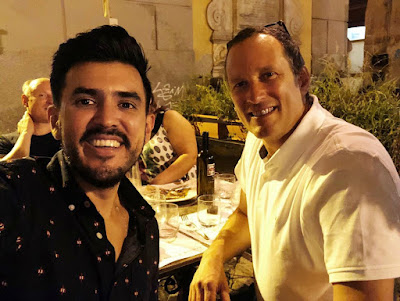SMARTI Fellows ... Winter has come ... keep walking ... never look back .!
Hello word...!!
Before we get into
the main topic of the post, I would like to thank you all, pavement lovers, because
we are now getting closer to pass the first milestone of the blog. We are
approaching the 2,000 views and I am extremely pleased to tell you that there
are viewers from all over the word, from Chile to New Zealand. Next milestone is
to double the viewings before the end of the year so I count on you to make it
happen.!
Well, let’s get back on “track”. On
this occasion, I will be taking you to two of the most beautiful cities that
Europe has, Paris and Nantes. As part of our training activities, the SMARTI
ETN Consortium met once again for the third training week. The theme was
Multi-Functional Transport Infrastructure and the locations for the meetings
could not be better. In Paris, we were at
The École Nationale des Ponts
et Chaussées (National
School of Road and Bridges).
This well-known and prestigious school is one of the oldest in France
and for a pavement engineer such as myself, a dream come true. The school was created in 1747 under the name of
École Royale des Ponts et Chaussées by Daniel-Charles Trudaine, Civil Engineer
and one of the primary developers of the present French road system. On
Wednesday afternoon, we travelled to Nantes to visit The French Institute of Science
and Technology for Transport, Development and Networks (IFSTTAR), some of you
might remember them from a previous post.
I could not resist to take a "selfie" at the entrance of such a prestigious School.
Every time that we, Early Stage
Researchers (ESR), get together, we start by doing a group activity called
“speed-dating” where we have the opportunity to put everyone up-to-date in the
development of our projects. This time, Ana Jimenez del Barco Carrion who is
the Project Manager, have a brilliant idea and grouped the researchers with
similar projects or visions which to me made more sense when discussing
progress and difficulties. As a result, we have managed to collaborate between
ourselves and send an abstract call “Towards
more sustainable Pavement Management practices using embedded sensor
technologies” submitted to Infrastructure Open Access Journal under the
SMARTI Special Issue. We all saw it as an opportunity to create conscience and
see how our research life’s will continue once this wonderful experience comes
to and end. So far, we are still having meetings and we have agreed on
finishing the paper by the end of summer.
During our stay in Paris, we had a
guide visit to “Sense-City”, a 9
million euros Facility for ANR’s Future Investment Program. Sense-City is a
state-of-the-art climate chamber that can cover two 400m² areas (mini-city) equipped
with sensors to study the performance of facilities and urban materials, monitor
the city of tomorrow by sending appropriate information, and study air, water
and soil pollution. We had a live demonstration on different projects but the
most impressive was to see how they can simulate the sun-hours and its effect
on the roads/houses/air/vegetation. One of the things that other fellows and I
discussed was on the effect that this type of research has on the environment.
We understand that in order to create something new, it needs to be studied and
proved, but some of us believed that there was an excessive use of resources.
Nonetheless, we hope the project keeps evolving and we look forward to seeing
the results in the near future. Equally interesting was the presentation on Nano-technology
and its use on civil engineering applications. SMARTI ESR-2 works with its
solution and if you have been following my research will find some similarities.
With an old friend, Søren Rasmussen, from Dynatest Denmark and our guided visit to Sense-City.
In order to warm-up things, we had
an internal competition called “Infra-hackathon”. We were asked to present a
solution to a current mobility problem where we needed to increase the number
of travellers without increasing the number of cars. Also, we needed to find a
way to finance the project as there was not budget from central government and adding
tolls was not an option. Wind energy harvesting was the most popular option among
the groups as a way to make the infrastructure self-powered as well as smart barriers
for traffic distribution. I guess the objective was to make the ESR’s think on how
current infrastructure could be transformed to serve more than one purpose in
the future.
The challenge: Infra-hackathon. Thanks Emmanuel.!
Finally, we had a guided visit to
IFSTTAR Nantes where the concept Accelerated Pavement Testing (APT) was
presented to us. Pier Hornych, LAboratory for Modelling, Experimentation and
Survey of transport infrastructures (LAMES), introduced the Fatigue
Carrousel and walked us through the process of designing, constructing,
measuring, and modelling an APT experiment which was a lifetime experience for
some of the ESR’s, specially for those who work/love pavement engineering. Personally,
it was an enrichment experience to have a third visit to the carrousel and a
motivation/challenge to promote this type of research back in my home country,
Ecuador.
Pier Hornych and Juliette Blanc walking us though the concept of APT.
SMARTI ETN group photo during our visit to the Fatigue Carrousel.
Well my beloved pavement lovers,
I guess it’s time to end this post but keep in touch for more exciting news on
the development of my project...!
Mario Manosalvas Paredes.


































